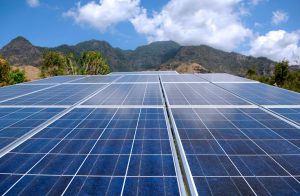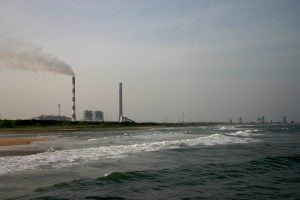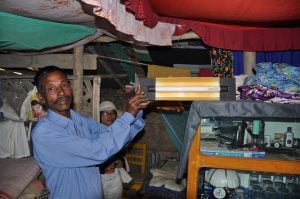Along the busy National Highway 8 that connects New Delhi to Jaipur there are dozens of young men involved in an illicit trade. Sitting in front of plastic bottles and containers of yellowish liquid these young men are selling fuel at a cut rate price to motorcycle and truck drivers.
The prices are much lower than at regular fuel stations, and are made possible because anywhere between a tenth and a third of the fuel is adulterated with kerosene.
Kerosene is supposed to be India's "poor man’s fuel”. It's a petroleum product that is heavily subsidised by the federal government and sold at half its market value. Its use is targeted at the poor and those living in remote areas. Together with liquefied petroleum gas (LPG) or cooking gas, it is meant to be used for cooking and lighting to reduce the burning of wood, dry leaves, agricultural waste and cow-dung cakes. Fuel subsidy policies are determined by the federal government but kerosene is distributed through a public distribution system of shops run by provincial or state governments.
Kerosene is supposed to be sold at the officially administered price of INR 14.96 (US$0.22) per litre, which is much lower than the market price of INR 29.91 (US$0.44) or the price at which oil refining and marketing companies, most of them owned by the government, would need to break even.
Subsidised and stolen
The Ministry of Finance's annual Economic Survey, found that as much as 41% of publicly distributed kerosene is “lost as leakage and only 46% of the remainder is consumed by poor households.” What is not explicitly stated is that “leakages” include illegal diversion.
Government attempts to curb adulteration, including colouring kerosene blue, have mostly failed because the incentives are huge. Diesel and petrol cost roughly four times more than kerosene, and without a laboratory test, the fuels can be mixed with kerosene at a proportion of 10% to 20% without being detected.
Black market profits are enormous. One government estimate suggests the covert business could be worth as much as INR 100 billion per year (US$1.5 billion).
Organised criminal groups are diverting kerosene to the black market and have no qualms about protecting their interests. At least two officers were killed recently by the fuel mafia. Yeshwant Sonawane was burnt alive in January 2011 in Malegaon, Maharashtra, when he attempted to stop rampant adulteration of petrol with kerosene. Similarly, Shanmugam Manjunath, a young manager who worked for the public sector Indian Oil Corporation (IOC), was murdered in November 2005 for shutting down a corrupt petrol station in Lakhimpur Kheri, Uttar Pradesh.
As estimated 300 million people in India, roughly one-fourth of the population, do not have access to energy. Subsidies and spending on energy are both urgent and contentious issues that feature heavily in the country's economic and political debates. In 2015, the Comptroller and Auditor General of India (CAG), the apex government auditor, revealed that the government had understated the cost of subsidies for 2015 by INR 44,941 crore (US$6.7 billion).
However, in the same year, the federal government claimed that reforms were bringing subsidies under control. It estimated the total subsidy bill for 2015-16 to be around INR 40,000 crore (US$5.9 billion). The government is now attempting to ensure what it calls direct benefits transfer, which entails moving the subsidy element on a cylinder of liquefied petroleum gas (LPG), used mainly for cooking, directly into the bank account of the intended beneficiary by linking it to India's “Aadhaar” national identity card.
So far, the reforms have met with limited success. Roughly a fourth of India's population does not have a bank account, and many existing accounts are dormant with a zero balance.
A research study on fossil fuels by the International Institute for Sustainable Development reveals that during 2013 and 2014, on average, India provided INR 697.31 crore (US$103 million) per year in national subsidies to gas, oil and coal producers over and above the subsidies given to consumers.
Unsustainable subsidies
Many economists have long argued that India cannot sustain its current subsidy regime. This is because costs extend beyond official pre- and post-tax subsidies given to producers and consumers to include lost tax revenues amd additional "externalised" costs such as climate change and pollution. It is also challenging to account for cross subsidisation in official calculations.
Yet, in India, as in other countries, removal of subsidies designed to help the underprivileged – even if the subsidies do not reach them – is politically difficult.
There are currently three government ministries dealing with energy: coal, power, and new and renewable energy. They report to the Minister of State with Independent Charge for Power, Coal, New and Renewable Energy, Piyush Goyal. The coal ministry determines coal policies and strategies with public sector coal companies, while the power and new and renewable energy ministries guide major research and development initiatives.
Oil refining and marketing is dominated by a clutch of oil corporations led by the Indian Oil Corporation (IOC), one of the biggest companies of its kind. The IOC sells a little under half of all petroleum products in India and accounts for almost a third of the country’s total crude oil refining capacity.
The subsidy scenario for petroleum products is complicated because both the federal government and 29 state governments are involved. While policies and decisions on subsidies are made in Delhi, the actual distribution is carried out through the civil supplies departments of state governments. When issues relating to leakage and adulteration arise, it is difficult to apportion blame or responsibility.
For India, the issue of energy subsidies is particularly significant because it is the world’s third largest energy consumer and the second most populous nation. Given its urbanised, manufacturing-driven development agenda, its energy requirements are expected to grow rapidly.
According to projections made by the International Energy Agency, India’s energy consumption will be greater than the member countries of the Organisation of Economic Cooperation and Development (OECD) in Europe and will approach that of the United States by 2040. However, while such growth in energy consumption is significant, in per capita terms, India still consumes far less energy than the United States or China.
India’s total energy consumption in 2014 was 872 Mtoe (million tonnes of oil equivalent), whereas in the United States and China consumption for the same year was 2,224 Mtoe and 3,034 Mtoe respectively.
Globally, energy subsidies are projected at US$5.3 trillion in 2015 (6.5% of global GDP), according to a recent study by the International Monetary Fund (IMF). A large part of this is because countries are setting energy taxes below levels that genuinely reflect the environmental costs of energy consumption. The IMF’s country profile places India’s post-tax subsidies on petroleum at US$72.19 billion, on coal at US$195.82 billion and on natural gas at US$9.29 billion.
The subsidy regime in India shows that despite the noble policy objective of bringing about “inclusion”, poorly targeted subsidies can have perverse effects.
This article is republished from Indian Climate Dialogue







